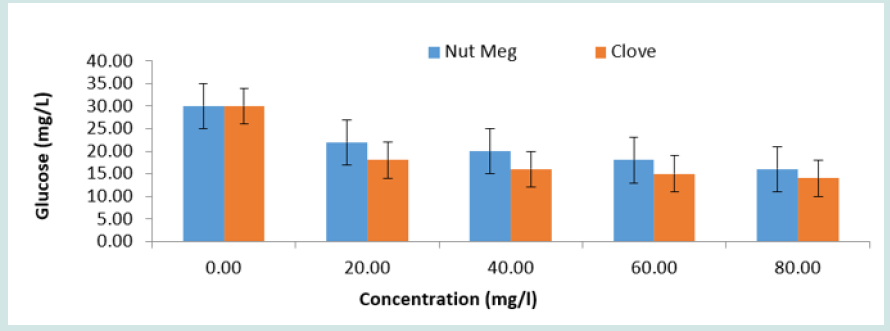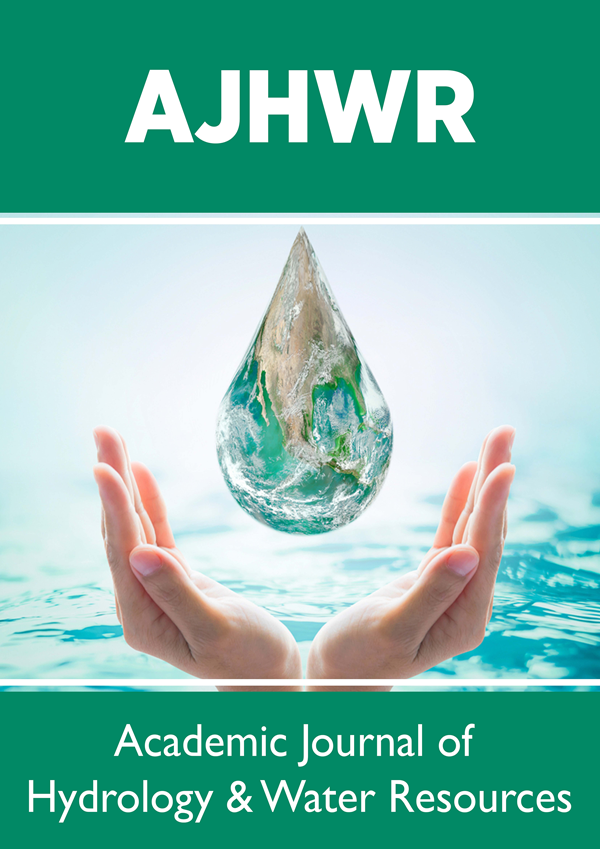Lupine Publishers Group
Lupine Publishers
Menu
Research Article 
Efficacy of Some Plant Extracts as Anaesthetics Agent in Tranportation of Nile Tilapia (Oreochromis niloticus) Volume 1 - Issue 2
Abu OMG1*, Ayaobu Cookey IK2 and Nwanyanwu UG3
- 1,3Department of Fisheries and Aquatic Environment, Faculty of Agriculture, Rivers State University, Nkolu-Oroorukwo, Port Harcourt, Rivers State, Nigeria.
- 2Department of Aquaculture, Nigerian Institute for Oceanography and Marine Research, Victoria Island, Lagos
Received: October 9, 2023 Published: October 18, 2023
Corresponding author: Abu OMG, Department of Fisheries and Aquatic Environment, Faculty of Agriculture, Rivers State University, Nkolu-Oroorukwo, Port Harcourt, Rivers State, Nigeria.
Abstract
The effectiveness of clove and nut Meg seed extracts as an aesthetic agent in transportation of Oreochromis Nilotic us was carried out. A total of 600 specimens of O. Nilotic us fingerlings (mean length 6.87cm±1.54 SD and mean weight 10.23g±1.23SD), and Juveniles (mean length 10.34cm±2.02 SD and mean weight 33.13g±4.55 SD) were procured from African Regional Aquaculture Centre, (ARAC), Aluu, Rivers State of Nigeria. They were exposed in three replicates to different concentrations (0.00mg/L- control; 10.00; 20.00; 30.00 and 40.00 mg/L) of clove and nut Meg seed aqueous extracts. The exposed fish were later transported in open plastic tanks from ARAC, in Aluu to Rivers State University, Port Harcourt over 60km. During this process, the survivals of the transported fish were monitored at time intervals of 20, 40, 60, and 80 minutes. At the end of the experimental period, glucose levels in the plasma of the fish were assessed. The result of the study indicated that the survival of the fish increased significantly (P<0.05) with increasing concentration of the anesthetics in both juveniles and fingerlings of the exposed fish. The lowest survival rate (10.0%) was recorded in the fish transported with no anesthetics, while 100% survivals were recorded in fish exposed to 40.0 and 50.0 mg/L of the extracts. In conclusion, this study suggests that application of clove and nut Meg seed extracts within the range of 30.00 and 40.00 mg/L reduced the stress response in Nilotic’s during transportation and enhanced their survival.
Keywords: Aquaculture, Transportation, Tilapia, Stress, Anesthetics.
Introduction
Fish transportation, which entails moving small or large quantities of fish over various distances to the seas where they are to be stocked, is a crucial component of aquaculture operations [1, 2]. Fish are frequently moved for a variety of purposes, including the gathering and transportation of brood stock, fingerlings, juveniles, and adult fish to stocking sites or markets, as well as the introduction of fish species into a new culture setting [3,4,5]. According to several writers, moving fish from one place to another can cause stress, which has a detrimental impact on the fish’s performance and reduces its survival in the culture medium [6,7,8]. Thus, acute stimuli including handling and transport have been linked to significant losses and high mortality in newly stocked fish farms [9,10]. Transport times might vary greatly based on the distance traveled as part of the handling procedures in intensive fish farming. In general, juveniles and fingerlings are moved from the hatchery to the culture site. To achieve the requirements set forth by the farmer, the fish must enter the farm in acceptable physiological condition [11].
To reduce the anxiety caused by aquaculture treatments, anesthetics are employed. Fish that have been anesthetized before being transported have lower metabolic rates, lower oxygen demands, less general activity, less impact from handling, and less likelihood of stress reactions. The primary materials employed in this investigation are an aqueous extract of the clove plant’s seed (Syzygium aromaticum) and nutmeg. Eugenol (70–90%) is the primary and active component. Due to their accessibility, affordability, and safety for both humans and fish, clove extracts are regarded as an acceptable anesthetic for fish [12, 13]. Clove seed is being utilized as a food additive in Nigeria. An important cultured species in Nigeria is Oreochromis Nilotic us, and fish farmers typically transfer these fish to the location where they will be cultivated. They typically arrive at a particular location in appalling physiological circumstances, which has a detrimental effect on their chances of surviving and doing well in the cultural system. Therefore, this study will be conducted to evaluate the effectiveness of certain plant extracts from clove calyxes as anesthetics in Oreochromis Nilotic us transportation.
For usage in handling and transporting fish in intensive aquaculture, plant extracts have the potential to yield new and strong anesthetics. It is therefore necessary to develop a workable alternative anesthetics of plant origin which could be used in fish transportation. With the recent awareness on safe aquaculture practices, to develop “green” anesthetics with low environmental and health risks, coupled with the prohibitive cost and scarcity of conventional anesthetics [14]. Many farmers reported fatalities when moving various mullet, tilapia, and clariid species. In addition to raising awareness of the effectiveness of these plant extracts that could be used as an alternative to pharmaceutical anesthetics, this effort will provide information on the use of local anesthetics such as clove seed and nut Meg seed extracts. The results of this study will aid in managing the strain associated with fish farming and increase production in numerous fish farms in Nigeria, namely in the Niger Delta, as well as in other locations where such negative effects of transportation have been noted. The purpose of the study is to determine whether clove seed and nutmeg extracts are effective as anesthetics when transporting Oreochromis Nilotic’s.
Material and Methods
Fish experimental sources
A total of 450 O. Nilotic us fingerling specimens were obtained from the production ponds at the African Regional Aquaculture Centre (ARAC), Aluu, Rivers State, Nigeria (mean length 87cm; standard deviation, 1.54; and mean weight 10.23g; standard deviation, 123).
Fish used in experiments are acclimated
They were brought in 50L jerry cans to be acclimated for seven days in the Fish Disease Laboratory at the Center. They received ARAC feed (35.0% CP) at 3% body weight during this time. Every two days, the water in the acclimation tanks was replaced [15].
Preparation of plant extracts
Nutmeg (Myristica fragrans), and dried buds of clove plant, (Syzigium aromaticum) were purchased from Choba Market in Obio Akpor Local Government Area of Rivers State. Plants authentication was done using the keys of Agbaje, [16]. These seeds were taken to the laboratory and ground into power using a kitchen blender (Model H2, Ken Wood, Japan). The milled seeds were sieved using 0.1 micro nylon mesh to obtain the fine powder.
Experimental design
The design of the experiment was Completely Randomized Design (CRD) having five treatments levels each with three replicates for each of the life stages. A total of 75 plastic basins of dimension (52 x 44 x 34 cm3) each were used for the experiments. The 75 basins were labeled based on life stage of the fish, treatment levels and replicates. Each basin was stocked with five (5) fish per tank. A total of 225 (two hundred and twenty-five) fish were stocked.
Experimental procedure
The powder was weighed into different concentrations (10.0, 20.0, 30.0, 40.0 and 50mg/l) using a sensitive weighing balance. It was applied directly in three replicates into the water (10L) level in 30L experimental plastic aquaria. The mixtures were stirred vigorously to ensure homogenous mixture. The fish was weighed with 20 kg round top weighing scale (Model 1123HK, Digital Scales, Ltd, Beijing, China). While the length was measured with transparent meter rule. They were then introduced into prepared experimental aquaria, containing five concentrations of each of the powdered plant seeds (10.00; 20.00; 30.00; 40.00 and 50.00 mg/l) at the rate of five fish per tank in triplicates. The Fish was then transported from the ARAC farm in Aluu to Rivers State University fish farm in department of Fisheries and Aquatic Environment, over 60km. Before and after transportation, blood samples (l ml) will be taken for glucose test from the Vena caudalis of the fish using a 5ml syringe fitted with 21G needle. The glucose levels were evaluated with glucose meter (Accuchek model RS 910, China). The survival of the experimental fish was observed and recorded in each of the concentration.
Determination of induction and recovery time
The time for onset of anesthesia for the exposed fish was measured in all the plant extracts using a digital stopwatch. Fish behavior was monitored individually through the induction and recovery stages in each life stage and concentrations (Table 3.1). In the induction stage, five different behaviors were observed [17]. After the anesthesia, the fish was removed individually using a scoop net and transferred into a clean water tank. Recovery time followed the following stages: reappearance of opercula movements, partial recovery of equilibrium, irregular balance, total recovery of equilibrium and lastly, normal swimming was observed and recorded.
Evaluation of water quality parameters
The water pH was determined in situ in each of the aquarium with a pH meter (Hanna Products, Portugal). This was achieved by dipping the end of the electrode into the test solution and the mode button was selected and reading was taken. The temperature of the water was measured by placing the mercury in glass thermometer in the water and taking a reading after five minutes at 15cm depth. While the values of Ammonia, dissolved oxygen and supplied were evaluated using LaMotte freshwater test kit (Model AQ4, Chestown, Maryland, USA).
Statistical analysis
The data obtained from the study was collated and analyzed using statistics software 8.0 for windows. Data was first tested for normality (Kolmogorov - Smirnov test) and homoscedasticity of variance (Bartletts test). When these conditions were satisfied, a two-way analysis of variance (ANOVA) was employed to reveal significant differences in measured variables among control and experimental groups. When a difference is detected (P<0.05), Tuckey’s multiple comparison test was applied to identify which treatment are significantly different.
Results
The water quality parameters in experimental tanks of O. Nilotic us exposed and transported with clove seed extracts are presented in (Table 1). The results indicated a significant reduction (P<0.05) in the values of dissolved oxygen, in the water without anesthetics (0.00mg/l). Whereas higher values of ammonia and supplied were also recorded in the control. While other water quality parameters were within the same range with no significant different in relation to the concentration of the anesthetics (P>0.05). Mean values for the water quality variables such as temperature, pH, dissolved oxygen (DO), ammonia and supplied obtained during exposure of Nilotic’s to nut meg seed extracts are presented in (Table 2). Lower values of dissolved oxygen were observed in the control, when compared to other concentrations. Whereas higher values of ammonia and supplied were also recorded in the control. While temperature and pH values were within the same range with no significant different (P>0.05).
The survival in the fingerlings of Nilotic’s exposed to nut Meg seed extracts is presented in (Table 3). The survival of the fish decreased significantly (P<0.05) as the transportation time increased. The lowest survival rate (20.00%) was recorded in the fish with no anesthetics (control), in 80 minutes, while the highest values of survival were observed in the fish transported with 40.00mg/l concentration of nut meg. The same trend was observed in the juveniles of O. Nilotic us transported with nut Meg (Table 4). After 80 minutes, the lowest survival rate (10.0%) was recorded in the control. While the highest survival (95.0) was recorded at 40.0 mg/l of the anesthetics.
Table 1: Water Quality Parameters in Experimental Tanks of Nilotic’s Fingerlings Exposed to Clove Bud Extracts (Mean ± SD). Means within the same column with different superscripts are significantly different (P < 0.05).

Table 2: Water Quality Parameters in Experimental Tanks of Nilotic’s Fingerlings Exposed to Nut Meg Extracts (Mean ± SD). Means within the same column with different superscripts are significantly different (P < 0.05).

Table 3:Survival (%) in Nilotic’s Fingerlings Transported with Nut Meg Extracts. Means within the same column with different superscripts are significantly different (P < 0.05).

Table 4:Survival (%) in Nilotic’s Juveniles Transported with Nut Meg Extracts. Means within the same column with different superscripts are significantly different (P < 0.05).

The percentage survival in the fingerlings of Nilotic’s transported with clove seed extracts are presented in Table 4.5. Generally, the survival of the fish decreased significantly (P<0.05) as the transportation time increased, except at 40.0 mg/l concentration of the anesthetics. The lowest survival rate (30.00%) was recorded in the fish with no anesthetics (control), in 80 minutes, while the highest values of survival (100.0 %) were observed in the fish transported with 40.00mg/l concentration of clove seed extracts. The same trend was however observed in the juveniles of O. Nilotic us transported with clove seed extracts (Table 5). At the end of 80 minutes, the lowest survival rate (10.0%) was recorded in the control. While the highest survival (100.0) was recorded at 40.0 mg/l of the extracts.
Table 5:Survival (%) in Nilotic’s Fingerlings Transported with Clove Bud Extracts. Means within the same column with different superscripts are significantly different (P < 0.05).

The comparative glucose levels in Nilotic’s juveniles transported with nut Meg and clove seed extracts are presented in (Table 6, 7). Before transportation the glucose levels were within the same range in all concentrations of exposure. The glucose levels in the fish exposed to both nut Meg and clove decreased significantly (P<0.05), with increasing concentrations of the anesthetics. Comparative survival of in the fingerlings and juveniles of Nilotic’s transported with nut Meg and clove seed extracts are shown in (Figure 1, 2 & 3). The results indicated that a higher survival rate was recorded in fish transported with clove seed extracts when compared to nut Meg extracts in both sizes.
Table 6:Survival (%) in Nilotic’s Juveniles Transported with Clove Bud Extracts. Means within the same column with different superscripts are significantly different (P <0.05).

Table 7:Comparative Glucose Levels in Nilotic’s Juveniles Transported with Nut Meg and Clove Seed Extracts (Mean ± SD). Means within the same row with different superscripts are significantly different (P <0.05).

Figure 1: Comparative Survival in Fingerlings of Nilotic’s exposed to Nut meg and Clove Seed Extracts.

Figure 1: Comparative Survival in Juveniles of O. Nilotic’s exposed to Nut meg and Clove Seed Extracts.

Figure 3: Comparative Glucose Levels in Nilotic’s Juveniles Transported with Nut Meg and Clove Seed Extracts.

Discussion
Long recognized is the necessity for a method of immobilizing aquatic species without harming the victim. According to documents, fish immobilization has been the topic of basic and applied research that has been especially relevant to aquatic animals employed in aquaculture. Nowadays, immobilizing fish using anesthesia is a standard practice. Anesthesia usage may increase transit survivability [18]. In this study, fish exposed to various doses of clove and nutmeg seed extracts had good survival rates. This finding supported that made by Adamek et al. [19] about the movement of Indian shrimp (Fenneropenaeus indicus). This, according to Akinrotimi et al. [20], is a result of the fish being able to breathe adequately, maintaining homeostasis during transit, and increasing its survival due to the light anesthesia caused by clove application for the alleviation of transportation-related stress. Along with decreased activity, aquatic animals are transported with their metabolic rates reduced using mild doses of anesthetics. This could lessen physiological stress, oxygen consumption, and the formation of CO2 and ammonia [21, 22], which would reduce fatalities during and after transportation.
The water quality parameters in experimental tanks results indicated a significant reduction in the values of dissolved oxygen, in the water without anesthetics (0.00mg/l). Whereas higher values of ammonia and supplied were also recorded in the control. While other water quality parameters were within the same range with no significant different in relation to the concentration of the anesthetics similar result was observed in the transportation waters of Clarias Garie Pinus using clove [23] This is because use of anesthetics in fish transport minimizes its activity, and the excretion of ammonia through the gills. Hence clove and nut Meg seed extracts maintain a relatively good water quality during fish transportation [24]. However, Winton [25] reported that typical oxygen consumption rates of spring Chinook salmon, Oncorhynchus tshawytscha smolts are 210 mg kg/1h/1 in untreated transportation tank water and 190 mg kg/1h/1 when 10 mg/L MS-222 is added. Kolarova et al., [26] have also observed that 2-phenoxyethanol did not affect the oxygen consumption or ammonia production of goldfish, Carassius auratus during transport; on the other hand, Lays et al., [27] have showed that it suppressed oxygen consumption rates of guppy, Poecilid reticulata, in simulated transportation experiment. In simulated air transport of platy fish, Xiphophorus maculates, 2-phenoxyethanol and quinaldine sulphate were efficient in decreasing the excretion of CO2 and ammonia, MS-222 reduced ammonia but not CO2 production and metomidate had no effect on excretion of metabolic wastes [28]. Iversen et al. [29] observed that the use of anesthetic (ethyne glycol-monophenyl ether) during simulated transportation of red porgy, Pagrus pagrus fry had no significant effect on CO2, NH3 and NH4 concentrations of exposure water. The results showed by Leji et al., [30] experiment indicate wide variation in oxygen consumption between six species of fish in response to low concentrations of clove oil during extended exposure. These examples indicate that different anesthetics may differ in their efficiency, and it may also indicate the presence of inter fish-species variability in metabolic rates during exposure to low sedation concentration of anesthetics.
In aquaculture practices the understanding of fish stress response is essential to avoid stress-related problems, and to improve fish quality in rearing conditions to optimize production. As in other vertebrates, fish experiencing stress show several physiological changes that are expressed through several indicators [31]. Stress has been described as an energy drain of energy that might be utilized in growth diverted to catabolic utilization [32]. However, mobilization of readily available energy in the form of glucose is suggested to enhance the survival of fish. It is perhaps not surprising, therefore, that elevation of plasma glucose has been recognized as a part of generalized stress response in fish. The reduction in glucose levels of O. niloticus juveniles with increased concentrations of clove and nut Meg extracts in this work is similar to the findings of Akin Rotimi et al. et al. [33] in Sarotherodon melanotheron transported with clove oil. However, Lambooij et al. [34] observed an increase in glucose levels of common carp (Cyprinuscarpio) transported with anaesthetic metomidate, this contradictory trend according to Akinrotimi et al. [35] lies in the ability of clove to block cortisol secretion which stimulate glucose production. Cortisol is considered to be a major mediator of the increase in plasma glucose levels seen in stressful fish (Barton, 2002).
Conclusion and Recommendations
In conclusion, results indicated that glucose levels in Nilotic’s juveniles transported with nut Meg and clove seed extracts decreased significantly (P<0.05), with increasing concentrations of the anesthetics. Comparative survival of in the fingerlings and juveniles of Nilotic’s transported with nut Meg and clove seed extracts indicated that higher survival rate was recorded in fish transported with clove seed extracts when compared to nut Meg extracts in both sizes. The water quality parameters in experimental tanks results indicated a significant reduction (P<0.05) in the values of dissolved oxygen, in the water without anesthetics (0.00mg/l). Whereas higher values of ammonia and supplied were also recorded in the control. While other water quality parameters were within the same range with no significant difference in relation to the concentration of the anesthetics. From the results obtained in this study, a concentration of 40.0 mg/l of nut Meg extracts is ideal for transportation of both fingerlings and juveniles of O. Nilotic us. While a lower concentration of 30.0 mg/l of clove seed extracts is recommended for transportation of Nilotic’s in aquaculture with little or no mortality.
References
- Orji RCA (2005) The effect of transportation stress on haematocrit level of Orechromis niloticus. Animal Research International 2(1): 224-226.
- Akinrotimi,A, Ansa E, Owhonda KN, Ononkwo DN and Edun OM, et al. (2007) Effects of transportation stress on haematologcal parameters of black chin tilapia, Sarotherodon melanotheron. Journal of Animal and Veterinary Advances 6(7): 841- 845.
- Baker DW, Wood AM, Litvak MK, Kieffer JD (2016) Haematology of Juvenile Acipenser oxyrinchus and Acipenser brevistrom at rest following forced activity. Journal of Fish Biology 66: 208-221.
- Cooke SJ, Sunk CD, Ostrand KG, wahl DH (2004) Behavioral and physiological assessment of low concentrations clove oil anaesthetic for handling and transporting largemouth bass. Aquaculture 239: 509-529.
- Akinrotimi OA, Edun OM, Mebe ED (2013a) Effects of clove seeds as anaesthetic agents in two species of grey mullets Liza falcipinnis and Liza grandisqumis. Journl of Aquatic Science 1(1): 7-10.
- Ashley PJ (2007) Fish welfare: current issues in aquaculture. Applied Animal Behaviour Science 104: 199-235.
- Akinrotimi OA, Edun OM, Ukwe OIK (2018) Effects of Anaesthetics on Metabolic Enzyme Activities in African Catfish, Clarias gariepinus (Burchell, 1822) Journal of FisheriesSciences.com 12(1): 022-028.
- Akinrotimi OA, Abu OMG, Aranyo AA (2011) Environmentally friendly aquaculture key to sustainable fish farming development in Nigeria. Continental Journal of Fisheries and Aquatic Science 5(2): 17-31.
- Iwama GK, Thomas PT, Forsyth RB, Iwama GK and Pickering AD et al. (1998) Fish Stress and Health in Aquaculture London, UK: Cambridge University Press.
- Akar AM (2011) Effects of clove oil on the response of blue tilapia (Oreochromis aureus) by transportation stress. Journal of the Arabian Aquaculture Society 6(1): 77-86.
- Carneiro PC, Urbrinati EC, Martins ML (2002) Transport with different concentration of benzocairne concentrations and its consequences on haematological parameters and gill parasite populations of matrixa. Acta Science 24: 555-56.
- Small BC (2004) Effects of isoeugenol sedation on plasma cortisol, glucose that lactate dynamics in channel catfish, Ictalurus Punctatus exposed to three stressors. Aquaculture 238: 469-481.
- Summerfelt RC, Smith LS (199O) Anaesthesia surgery and related techniques. Methods for Fish Biology (Schreck, C.B.,& Moyel,P.B) Bethesda MD USA: American Fisheries Society.
- Akinrotimi OA, Gabriel UU, Deekae SN (2014b) Investigations on the potential of Indian almond free (Terminalia catapaa) leaf extracts as anesthetic agents in African catfish (Clarias gariepinus). Journal of Aquatic Sciences 29 (IB): 223-231.
- Gabriel UU, Ezeri GNO, Opabumi OO (2004) Influence of sex, source, health status and acclimation on the haematology of Clarias gariepinus. African Journal of Biotechnology, 3(9): 463-437.
- Agbaje EO (2008) Gastrointestinal effects of Syzigium aromaticum in animal model. Nigeria Quarterly Journal of Hospital Medicine 18(3):137-141.
- Coyle SD, Durborow RM, Tidwell JH (2004) Anaesthetics in aquaculture. Southern Regional Aquaculture center, 39: 1-20.
- Akinrotim OA, (2014) Assessment of the efficacy of synthetic and natural anaesthetics on the African catfish Clarias gariepinus (Burchell, 1822). PhD Thesis. Department of Fisheries and Aquatic Environment, Rivers State University of Science technology Port Harcourt. 260pp.
- Adamek Z, Tasic K, Paul K, Lamasic M (2016) The effect of 2-phnenoxyethanol narcosis on blood of young carp, Veterinary Archives 63: 245-250.
- Akinrotimi OA, Gabriel UU, Deckae SN (2014a) Anaesthetic efficacy of sodium bicarbonate and its effect on the blood parameters of African catfish, Ckarias gariepinus. Journal of Aquatic Sciences 29(IB): 223-246.
- Wedemeyer GA (1983) Some potentials and limits of the leucorit test as fish health assessment method. Journal of Fish Biology, 23: 711-716.
- Ross LG, Ross B (1999) Anaesthetic and sedative Techniques for Aquatic Animals. (1st edition). Oxford, London, UK: Black well science Publishers.
- Akinrotimi OA, Gabriel UU, Edun OM (2015) The efficacy of clove seed extracts as an anaesthetic agent and its effect on haematological parameters of African catfish (Clarias gariepinus). International Journal of Aquaculture and Fishery Sciences 1(2): 042- 047.
- Akinrotimi OA, Edun OM, Ukwe OIK (2018) Hormonal and glucose levels in Clarias gariepinus exposed to synthetic anaesthetic drugs. International Journal of Advanced Research in Medical & Pharmaceutical Sciences (IJARMPS-ISSN-2455-6998), 3(2), 7-12.
- Winton RE (1982) Interspecific Adaptation of Haemoglobin Function in Fish to Oxygen Availability., Oxford UK: Spronik, Pergamon Press.
- Kolarova M, Kolarova L, Perina A, Chalupa P (2002) Animal products and selected human infections disease. Cech Journal of Animal Science 47: 297-307.
- Lays N, Iversen MMT, Frantzen M, Jorgen EH (2009) Physiological stress responses in spotted wolfish (Anarhinchas minur) subjected to acute disturbance and progressive hypoxia. Aquaculture 295: 126-133.
- Hur JW, Park IS, KH, Chang YJ (2005) Changes of haematological characteristics of cultured sweet fish (Plecoglossus altivelis) by anaesthetic transport. Ocean Polar Research 27: 251-260.
- Iverseen M, Finstad B, Mc Kinley B, Elliassen R (2003) The efficacy of metomidate clove oil as anaestetics in Atlantic salmon (Salmo salar) and their potential stress reducing capacity. Aquaculture, 221: 549-516.
- Leji J, Babitha GS, Rejitha V, Ignatives J and Peter VS et al. (2015). Thyroid and osmoregulatory responses in tilapia (Oreochromis mossambicus) to the effluents of coconut husk netting. Journal of Endocrinology and Reproduction, 11: 24-31.
- Black JM, Morrissette JM, Landera-ternandez AM, Blakwell SB, and Black BA (2004) In situ cardiac performance of pacific blue fin tuna hearts in response to acute temperature change. Journal of Experimental Biology 207: 881-890.
- Akinrotimi OA, Edun OM, and Ukwe OIK (2018) Effects of Anaesthetics on Metabolic Enzyme Activities in African Catfish, Clarias gariepinus (Burchell, 1822) Journal of FisheriesSciences.com 12(1): 022-028.
- Akinrotimi OA, Aranyo AA, Ibemere IF (2011) Effects of capture, handling, and confinement on the glucose levels of black jaw tilapia Sarotherodon melanotheron. Advances in Students Research 1(2): 27-30.
- Lambooji B, Pilarcyzk M, Bialowas H Hens VD (2009) Anaesthetic properties of Fish-Culturist 19: 147-157.
- Akinrotimi OA, Gabriel UU, Orokotan OO (2013) Changes in Enzymes activities of Clarias gariepinus brood fish exposed to anaesthtics metomidate. Applied Ecology and Environmental Science, 1(3): 37- 40.

Top Editors
-

Mark E Smith
Bio chemistry
University of Texas Medical Branch, USA -

Lawrence A Presley
Department of Criminal Justice
Liberty University, USA -

Thomas W Miller
Department of Psychiatry
University of Kentucky, USA -

Gjumrakch Aliev
Department of Medicine
Gally International Biomedical Research & Consulting LLC, USA -

Christopher Bryant
Department of Urbanisation and Agricultural
Montreal university, USA -

Robert William Frare
Oral & Maxillofacial Pathology
New York University, USA -

Rudolph Modesto Navari
Gastroenterology and Hepatology
University of Alabama, UK -

Andrew Hague
Department of Medicine
Universities of Bradford, UK -

George Gregory Buttigieg
Maltese College of Obstetrics and Gynaecology, Europe -

Chen-Hsiung Yeh
Oncology
Circulogene Theranostics, England -
.png)
Emilio Bucio-Carrillo
Radiation Chemistry
National University of Mexico, USA -
.jpg)
Casey J Grenier
Analytical Chemistry
Wentworth Institute of Technology, USA -
Hany Atalah
Minimally Invasive Surgery
Mercer University school of Medicine, USA -

Abu-Hussein Muhamad
Pediatric Dentistry
University of Athens , Greece

The annual scholar awards from Lupine Publishers honor a selected number Read More...


